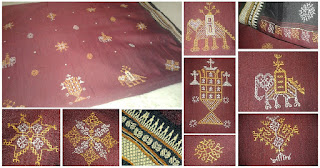 |
| Kasuti-embroidered Dharwar Cotton Saree |
The origins of Kasuti embroidery are far from clear though. Similar embroidery appears to have been executed in Egypt from where it may have spread both to Western Europe and to India in the East. Within India, Kasuti could be considered to be a variant of Kashida embroidery seen in the country's North; it may have come to Karnataka through the Lambini tribe which is believed to have migrated to Karnataka via Gujarat from Rajasthan.
There are four kinds of stitches which are generally used in Kasuti embroidery: (1) Gavanthi or Gaunti which is a running stitch rather like the Elizabethan Holbein stitch, (2) Muragi which is a zigzag stitch, (3) Menthe, which means fenugreek in Kannada, and is for all practical purposes, cross stitch that's used to fill in motifs, and (4) Negi which gives the impression of threads having been woven into the cloth.
The motifs themselves are often temple-based such as those of the tulsi plant and temple doorways, although elephants, palanquins, flowers, peacocks and vines are often embroidered. The most dense embroidery tends to be above the end-piece of the saree (and is called bugadi), from where it may peter out into butis on the main body of the saree.
 |
| Ilkal sarees (from Karnataka) worn by women from Southern Maharashtra. |
The word 'Kasuti' can literally be broken up to mean Kai-Suti or hand-cotton. However, the embroidery is not necessarily in cotton, and may be executed using threads from the saree itself, possibly in silk, ensuring that the colours of the embroidery blend into those of the saree (though not so completely that the embroidery is invisible: both Dharwar and Ilkal sarees may use different colours for the warp and the weft).